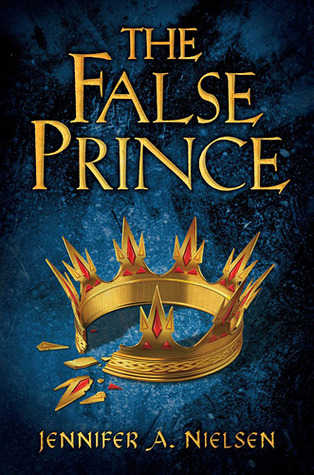 The Skinny: Sapphique is just as strong an installment as Incarceron and offers a well-rounded ending to the series, providing closure but also raising interesting questions as to what will ultimately happen to the main characters and their world. With sophisticated themes, the Incarceron series could be read as a rip-roaring adventure, as well as a thought-provoking tale that will incite conversation and remain with readers long after completing the books. Obviously one would recommend this title to those who have already read Incarceron, as I do not believe this would work very well as a stand-alone title. However, I would strongly recommend this series to those who enjoy sophisticated science fiction, fans of The Hunger Games, or fantasy fans who love authors with strong world-building chops.
The Skinny: Sapphique is just as strong an installment as Incarceron and offers a well-rounded ending to the series, providing closure but also raising interesting questions as to what will ultimately happen to the main characters and their world. With sophisticated themes, the Incarceron series could be read as a rip-roaring adventure, as well as a thought-provoking tale that will incite conversation and remain with readers long after completing the books. Obviously one would recommend this title to those who have already read Incarceron, as I do not believe this would work very well as a stand-alone title. However, I would strongly recommend this series to those who enjoy sophisticated science fiction, fans of The Hunger Games, or fantasy fans who love authors with strong world-building chops.

globe by Patrick Q
Setting: Incarceron (Inside the Prison) and the Realm (Outside the Prison)
Fisher delineates Inside from Outside carefully throughout this sequel. While both worlds were already well-defined in her previous novel, Incarceron, Fisher continues to vividly depict Incarceron as a cramped, half-mechanical, half-organic world of diverse landscapes and people all controlled by an experimental, sentient technology gone awry. The Realm remains a restricted, lush, and pastoral environment in which the affluent live in rejection of technological advancement (the Protocol), harkening back to a past era of landed nobility in both action and word, and in which the peasantry toil in imposed hardship to maintain a picturesque landscape for aristocratic play.

Tri Sandwich Faces by G. Russell
Characters:
Claudia, daughter of the Warden, has grown up playing the power games of court, having been raised to one day marry into the royal family and become queen. With her father missing somewhere in Incarceron, however, Claudia is left to handle the machinations of Queen Sia on her own. Backing Finn as the rightful heir leads to considerable trouble, both from the Queen who desires her own son, Caspar, to become King and from the Steel Wolves, a rebel group hoping to take down the Protocol of the Realm. And with Finn’s memory fragmented and his attitude forever changed by living in Incarceron, Claudia believably vacillates back and forth between supporting Finn as the rightful heir, Prince Giles, and in doubting his integrity. While in Incarceron Claudia was a strong, complex character, she seems a little pale by comparison in this installment; in Incarceron Claudia subverted Protocol to undermine the Queen and Caspar, while in Sapphique Claudia is depicted as being thoroughly entrenched in the ritual and pageantry. Claudia certainly still has a fighting spirit, but events seem to happen more to her rather than initiated from her.
Finn, former inmate of Incarceron, is still a well-realized and convincing character. Having been transported out of Incarceron to a world he thought to be full of freedom, he deals with the shocking realization that the Outside is not as perfect as he had assumed or hoped while trapped Inside the Prison. Struggling with an incapacitating guilt at having left behind his brother-in-arms, Keiro, and his friend, Attia, Finn feels lost in the curious and confining Realm. Throughout Incarceron, Finn was thought to be a “seer,” his seizures providing mystical knowledge; in trying to piece together his fragmented, pre-Incarceron memories and in battling his seizures, which he thought would disappear in the relative safety of the Realm, Finn spends much of his time alienating courtiers and upsetting those who say they are trying to help him.
Jared is a Sapient (or scholar of the Realm) in addition to being Claudia’s tutor; the affection between the two continues to be subtly described. In Incarceron, Jared constituted the one adult influence that remained positive, supportive, and genuine, but in Sapphique Jared and Claudia’s relationship becomes strained. In trying to protect Claudia, Jared plants seeds of doubt that Finn is actually Prince Giles and Jared makes a deal with Queen Sia that, at first, seems the ultimate betrayal. Throughout Sapphique Jared becomes a character with considerable more depth; though always an interesting character, Jared appears more independent, with adventures of his own and with an illness making him significantly physically weaker throughout the novel.
Although one might think from the first novel that Attia is a character foil inside the Prison to Claudia’s life out in the Realm, her role grows in Sapphique and she proves a strong, tough heroine who is fiercely loyal and sensitive to the struggles of others. Attia is the first character we met, as she begins making a life for herself after being left behind by Finn in Incarceron. While Attia is not always honest and certainly makes mistakes along the way, she also provides a necessary voice of reason within the tumultuous and sometimes irrational prison. She eventually travels with Keiro again, seemingly out of her love for Finn; while she does not believe Finn will necessarily return for her, she knows of his tie to Keiro. Until the very end, Attia fights to survive, but her sensitivity to the masses of innocent people inside the prison walls make her decisions more difficult and the ramifications of her choices more severe.
Keiro is as arrogant and feisty in Sapphique as he was in Incarceron, but his feelings of betrayal at having been left behind while Finn, he believes, is enjoying great riches and a life of great ease continually appear despite his cool façade. Keiro often acts out of purely selfish considerations and he attempts to maintain an air of indifference; yet his anger at Finn’s betrayal and his occasional kindnesses to Attia belie his spiky exterior. Keiro’s personality and ambitions remain constant throughout the series and a reader can rely on him to initiate action, to fight with little apparent concern for his own well-being, and to be fiercely loyal to his friends.

mouth by Darwin Bell
Voice:
Sapphique is told in third person, but providing the perspectives of Claudia, Finn, Jared, Attia and Keiro. Fisher beautifully captures these characters’ distinct voices, which under another’s pen might lead to terrible confusion. Each character is clearly drawn and their voices unique and immediately identifiable to readers. While much of the narrative is action-oriented and dialogue can occasionally be sparse, the interior lives and motivations of the main characters provide richness to the story and make each individual distinct, while simultaneously demonstrating their connections to one another.

Abstract (design) by tanakawho
Style:
As in Incarceron, each chapter begins with an excerpt from the life of Sapphique (a former inmate of Incarceron, thought to have escaped and imbued with mystical powers and religious reverence) or from a supposed publication of former Prison wardens or ancient Sapienti. These excerpts not only set the tone of the following chapters, but also help establish the world Fisher’s novels have created; these excerpts of folklore or “official” documentation imply a textual, religious, and creative past and present, lending a notion of multiple generations and of a vibrant intellectual, governmental and spiritual world in which these novels take place. Readers get the feeling that Incarceron and Sapphique constitute only one narrative of the many potential stories existing in this world. Fisher also excels in her description of the physical landscapes inhabited by her characters, giving enough detail to provide a reader with a clear sense of the environments, without hampering the reader with tediously long descriptive passages. More specifically, many of the details come in passing, as embedded in the action of the story, thereby allowing readers a nuanced picture with enough space for a reader’s imagination. As an adventure story, Sapphique is full of fast-paced action scenes, as well as moments of perceived calm that quickly turn dark. Fisher writes with an almost cinematic quality, as though one can imagine how the scene is staged and perhaps even hear the suspenseful music that would accompany it.

Interesting Basics – Yellow Triangle by qthomasbower
Story:
As a sequel, Sapphique picks up quickly where Incarceron left off; enough time has elapsed between the two that Attia has found her own way without Finn and Keiro and Finn has become uncomfortably embedded in courtly life. We meet Attia grabbing at straws, trying to find some way to escape from Incarceron, including joining ranks in a traveling magician’s act. After considerable adventures of her own, Attia double-crosses the magician with the help of Keiro and both Attia and Keiro continue their quest, armed with a mystical glove said to have been owned by Sapphique. On the outside, Finn, Claudia and Jared must maneuver the machinations of the Queen and her loyal followers, while trying to repair the portal that allows for travel between the Outside Realm and Inside Incarceron. The Queen tries her utmost to prevent the Portal from being restored, going as far as having her own castle set ablaze, while undermining the cause of Finn to claim the kingdom as rightful heir, Prince Giles. While those on the Outside desperately want to bring their friends back from Inside and those on the Inside struggle to find their own way Out, the Warden (Claudia’s father) has banned together with Incarceron in a plan to fashion a body for the Prison so it might escape itself.

two lines two shadows by miuenski
Themes:
The story of Sapphique repeatedly brings up the assumed division between the Inside and the Outside. The most obvious division exists between the Inside of Incarceron and Outside in the Realm of the Protocol, but other interior/exterior divisions present themselves. Insiders and outsiders in social groups exist in the Realm of the Protocol, such as those with the knowledge and affluence to exist and thrive inside the elite and those who have systematically been deprived and must toil on the earth to maintain the vision of the nobility. Insiders and outsiders also exist within the Prison; groups and social networks have formed to help those living inside survive hard conditions and strong bonds form between those who might lack other familial ties.
Over the course of the novel, however, the division between inside and outside becomes disrupted as those who have experienced both come to realize the limitations each world holds and the constrained social actions available in each. As the inside and outside come closer to imploding, readers can see how perception plays a vital role in how individuals define their realities. Most especially in the Outside Realm, the appearance of lush beauty is carefully concealing an ugly reality and the mutually agreed-upon delusion becomes reality through the actions of those who believe.
Read Full Post »
 The Skinny: Ten-year-old August “Auggie” Pullman was born with hereditary conditions that, even after multiple surgeries, have caused severe facial deformities. After years of being home schooled, August embarks on his first year in a private school, a year of challenges and triumphs. Wonder is an ultimately uplifting read, one that brings to the forefront kindness and courage. I would recommend this to fans of James Howe and Jordan Sonnenblick.
The Skinny: Ten-year-old August “Auggie” Pullman was born with hereditary conditions that, even after multiple surgeries, have caused severe facial deformities. After years of being home schooled, August embarks on his first year in a private school, a year of challenges and triumphs. Wonder is an ultimately uplifting read, one that brings to the forefront kindness and courage. I would recommend this to fans of James Howe and Jordan Sonnenblick. The Skinny: Fourteen-year-old Justin Thyme has made his family’s fortune as a successful scientist and inventor. When his mother, Lady Henny, is kidnapped and the ransom demands a time machine, Justin’s father, the Laird of Thyme, begins divulging secrets from his past. Justin Thyme is a humorous whodunit full of plot twists, eccentric characters and some serious speculation about the science of time travel. Although there seems to be almost too much going on and some passages are particularly dense and difficult to forge through, I would nevertheless recommend this title to fans of Nick of Time by Ted Bell or Gideon the Cutpurse by Linda Buckley-Archer. I would also recommend this to 5th-7th grade guy readers who like their mysteries with a little snark or their fantasy with a little eccentricity.
The Skinny: Fourteen-year-old Justin Thyme has made his family’s fortune as a successful scientist and inventor. When his mother, Lady Henny, is kidnapped and the ransom demands a time machine, Justin’s father, the Laird of Thyme, begins divulging secrets from his past. Justin Thyme is a humorous whodunit full of plot twists, eccentric characters and some serious speculation about the science of time travel. Although there seems to be almost too much going on and some passages are particularly dense and difficult to forge through, I would nevertheless recommend this title to fans of Nick of Time by Ted Bell or Gideon the Cutpurse by Linda Buckley-Archer. I would also recommend this to 5th-7th grade guy readers who like their mysteries with a little snark or their fantasy with a little eccentricity. The Skinny: When Ben Ripley is selected to attend the CIA’s Espionage Academy, a highly selective school that trains its students to become future operatives, he discovers himself in the middle of a dangerous plot to uncover a clandestine informant. This is a fast-paced and fun read and a good title to recommend to upper elementary or early middle school boys who are reluctant readers.
The Skinny: When Ben Ripley is selected to attend the CIA’s Espionage Academy, a highly selective school that trains its students to become future operatives, he discovers himself in the middle of a dangerous plot to uncover a clandestine informant. This is a fast-paced and fun read and a good title to recommend to upper elementary or early middle school boys who are reluctant readers.















 The Skinny
The Skinny
